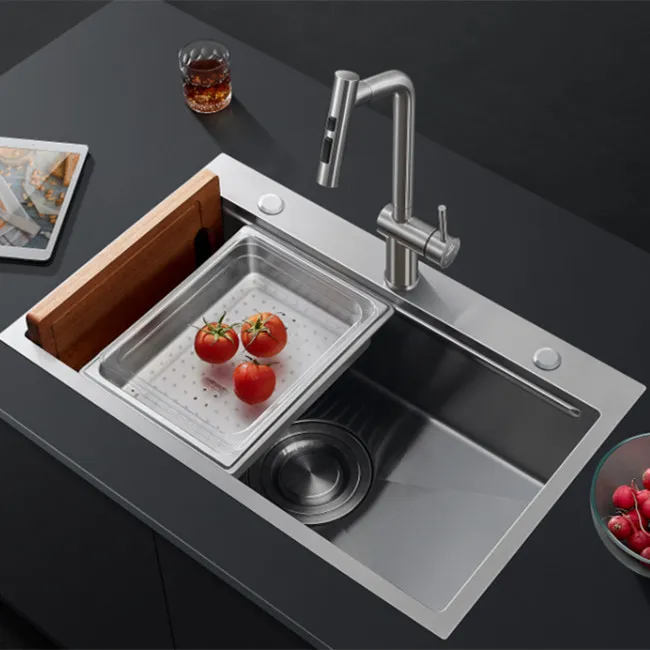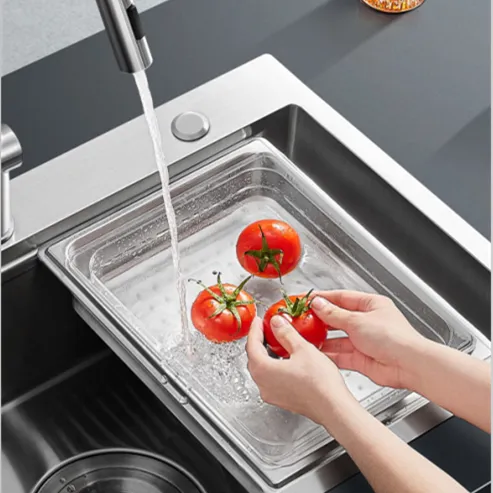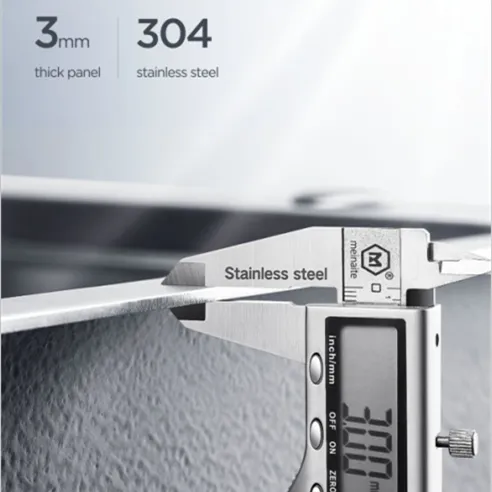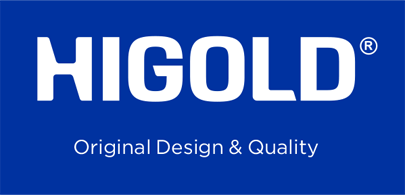In modern kitchen design, stainless steel sinks have become a mainstream choice.
However, when consumers choose products, they often see two common labels: 304 stainless steel and 316 stainless steel.
Many people wonder:
“Isn’t 316 a higher grade than 304?”
“Why do most kitchen sinks on the market still use 304 stainless steel?”
“What’s so special about a 304 stainless steel kitchen sink?”
This article will analyze the differences between 304 and 316 stainless steel from a professional perspective, helping you understand the real differences and why—
a 304 stainless steel kitchen sink is the best choice for your family kitchen.

What are the differences between 304 and 316 stainless steel?
Understanding the differences in the chemical composition and performance of the materials is key before choosing a kitchen sink.
1. Composition Comparison
Type | Main components | Nickel (Ni) content | Chromium (Cr) content | Other elements |
| 304 Stainless Steel | Fe + Cr + Ni | 8%~10.5% | 18%~20% | Mild amounts of carbon, manganese, and silicon |
| 316 Stainless Steel | Fe + Cr + Ni + Mo | 10%~14% | 16%~18% | Contains 2%–3% molybdenum (Mo) |
The core difference between the two is:
• 316 stainless steel contains molybdenum (Mo), making it more resistant to corrosion in strong acid and alkali environments.
• 304 stainless steel is renowned for its excellent overall performance, formability, and economy.
2. Material Performance Differences
Performance Indicators | 304 Stainless Steel | 316 Stainless Steel |
| Corrosion Resistance | Very Good | Excellent (especially in marine environments) |
| Moldability and Processability | Excellent | Good |
| High Temperature Resistance | High | Slightly better |
| Oxidation Resistance | Good | Excellent |
| Price | Moderate | Approximately 30%~50% better |
| Applications | Suitable for: Kitchen, Home Appliances, Medical Equipment | Chemical equipment, marine facilities, pharmaceutical equipment |
As the table shows, while 316 does perform better in extreme environments, its additional advantages are almost negligible in a kitchen environment.

Does a Home Kitchen Really Need 316 Stainless Steel?
Many people, upon hearing "316 is better than 304," mistakenly believe that a higher-grade material is necessarily more suitable for the kitchen. This is a common misconception.
1. Kitchen Usage Environment Analysis
In a home kitchen, the main substances that come into contact with the kitchen sink include:
• Tap water (low chlorine content);
• Dishwashing liquid, alkaline cleaners;
• Food residue, grease, and seasonings;
• Alternating hot and room temperature water.
Although this environment is humid, it is far less harsh than that of a chemical plant or a marine climate.
304 stainless steel kitchen sinks are perfectly resistant to corrosion and oxidation in everyday kitchen conditions.
2. What are the Strengths of 316?
316 stainless steel, containing molybdenum, performs better in environments with high salt, high chloride, or high acid/alkali concentrations.
For example:
• Ships, docks, and marine equipment;
• Containers in chemical or pharmaceutical plants;
• Salt spray or high humidity environments.
However, these are not typical home kitchen applications.
In ordinary kitchens, the rust resistance of 304 stainless steel is more than sufficient.

What are the advantages of 304 stainless steel kitchen sinks?
Let's analyze why the vast majority of high-quality kitchen brands choose 304 stainless steel as their primary material.
1. Excellent Corrosion Resistance
304 stainless steel contains 18% chromium and 8% nickel, forming a dense chromium oxide protective film on its surface, preventing moisture, air, and food acids/alkalis from contacting the metal substrate.
This protective film has self-healing capabilities; even if the surface is scratched, the protective layer will regenerate.
Therefore, 304 stainless steel kitchen sinks can remain rust-free and oxidation-free for many years.
2. Robust Structure and Strong Resistance to Deformation
304 stainless steel boasts excellent ductility and tensile strength.
During the manufacture of kitchen sinks, whether by hand welding or one-piece stretching, 304 ensures shape stability and is not prone to dents or deformation.
3. Hygienic and Safe, Meets Food-Grade Standards
304 stainless steel is a food-contact grade material, commonly used in tableware, cookware, and drinking water equipment.
It does not release harmful metal ions into water or food, ensuring kitchen hygiene and safety.
4. Easy to Clean and Resistant to Dirt Accumulation
The smooth and dense surface of 304 stainless steel makes it difficult for oil, pigments, and food residue to adhere.
It can be easily cleaned with warm water and a neutral detergent, resulting in extremely low maintenance costs.
5. Beautiful and Versatile Style
304 stainless steel has a natural metallic luster, offering a clean and modern visual appeal.
Whether it's a modern, industrial, or minimalist luxury kitchen design, a 304 stainless steel kitchen sink blends perfectly.
6. High Cost-Effectiveness
Compared to the expensive 316 stainless steel, 304 stainless steel has a significant cost advantage.
Users can obtain excellent durability and aesthetics within a reasonable budget.
The "Excessive Performance" Issue of 316 Stainless Steel Sinks
1. Significantly Higher Cost
Due to its molybdenum and higher proportion of nickel, the raw material cost of 316 stainless steel is approximately 30% to 50% higher than that of 304.
For an everyday kitchen sink, this additional cost does not translate into a proportional performance improvement.
2. Greater Processing Difficulty
316 material has higher hardness and slightly lower ductility, resulting in higher manufacturing costs and time.
For manufacturers, 316 is not the most economical material for kitchen sinks.
3. Performance Advantages Difficult to Demonstrate in a Kitchen Environment
304 already easily resists common kitchen irritants such as water, salt, alkali, and grease.
The "extra corrosion resistance" of 316 is almost meaningless in a typical household environment.
In other words, the advantages of 316 are "wasted" in the kitchen.

Will 304 stainless steel kitchen sinks rust?
This is a key concern for many users.
1. Theoretically, 304 stainless steel will not rust
Under normal conditions, the passivation film on the surface of 304 effectively prevents oxidation and corrosion.
2. "False rust" may occur in special circumstances
If the kitchen water contains iron particles or impurities, these deposits may form yellow spots on the sink surface, appearing as rust.
In reality, this is not oxidation of the 304 material itself, but rather external iron contamination.
It can be easily removed with lemon juice or stainless steel cleaning paste.
3. Proper use can keep it looking new for a long time
Avoiding prolonged water accumulation, grease, and salt buildup, and regularly cleaning and drying will keep your 304 stainless steel kitchen sink looking new for many years.
Why do most brands choose 304 stainless steel kitchen sinks?
1. Meets international standards
304 stainless steel meets American ASTM and European EN standards, belonging to the globally recognized food-grade stainless steel standard.
2. Perfect Balance of Cost and Performance
304 stainless steel achieves an optimal balance between strength, corrosion resistance, machinability, and price.
For kitchen products, it is the most economical, practical, and safest material.
3. High Market Maturity
The manufacturing process for 304 stainless steel kitchen sinks is mature, with highly compatible accessories and convenient installation and maintenance.
This is why almost all mainstream sink brands use 304 as their core material.
Daily Maintenance Suggestions for 304 Stainless Steel Kitchen Sinks
To keep your 304 stainless steel kitchen sink bright and clean for a long time, proper use and maintenance are crucial.
✅ Daily Maintenance Tips
• Wash and dry promptly after use: Prevent water droplets from forming limescale.
• Avoid strong acid and alkali cleaners: Use neutral detergents to prevent damage to the passivation layer.
• Do not pour grease or high-salt water directly into the sink: Prevent the formation of grease or chloride deposits.
• Clean with a soft cloth or sponge: Avoid scratching the surface with steel wool.
• Regular polishing and maintenance: A professional stainless steel cleaner can be used to restore its shine.
Key Reasons for Choosing a 304 Stainless Steel Kitchen Sink
Through the above comparison, we can draw a clear conclusion:
Comparison Dimensions | 304 Stainless Steel Kitchen Sink | 316 Stainless Steel Sinks |
| Corrosion Resistance | Sufficient for kitchen environments | Slightly better (but not significantly so) |
| Cost | Economical and practical | Expensive |
| Processability | Excellent, mature technology | Difficult to process |
| Hygiene and Safety | Food grade | Food grade |
| Aesthetics | High | High |
| Value for Money | Extremely high | Low |
| Application Scope | Suitable for family kitchens and dining spaces | Chemical, marine, medical applications |
✅ Conclusion:
• In a typical family kitchen, the performance of a 304 stainless steel kitchen sink is perfectly adequate;
• The additional properties of 316 stainless steel are of no practical value in a kitchen environment;
• From an economic, practical, and durable perspective, 304 is the more scientific and reasonable choice.
Which is more rust-resistant, a 304 stainless steel kitchen sink or a 316 stainless steel sink?
Theoretically, 316 is more rust-resistant, but in the kitchen environment, there is almost no difference between the two.
Will a 304 stainless steel kitchen sink fade?
No. 304 stainless steel has no coating and there is no issue with fading.
How to identify 304 stainless steel?
You can test it with a magnet: 304 stainless steel is almost non-magnetic; you can also check the manufacturer's material certificate.
What is the lifespan of a 304 stainless steel kitchen sink?
Under normal use and maintenance conditions, the life span can reach more than 10 years.
Are high gold sinks certified for international markets?
Yes, all Higold sinks comply with strict international certifications including CUPC, CSA, CE, and CGC. These approvals allow buyers to import and sell our products with confidence in their safety and durability. As a trusted manufacturer, we ensure every batch meets export standards.
Purchasing managers can request quotes, benefit from wholesale prices, and buy sinks that already carry the required certificates for global sales.


